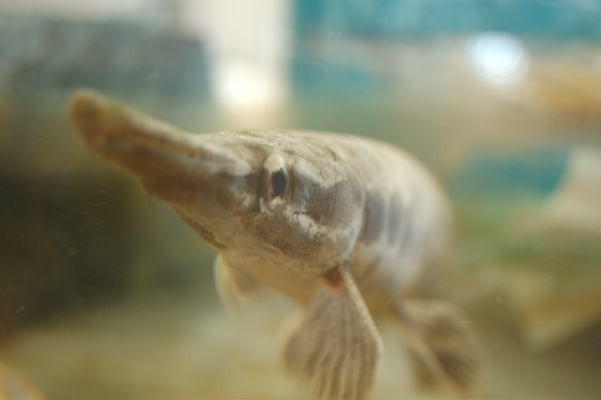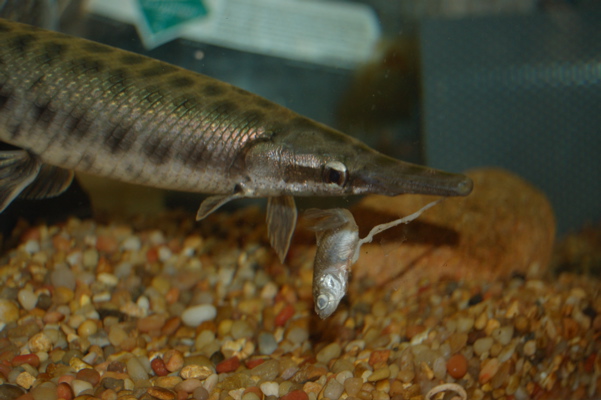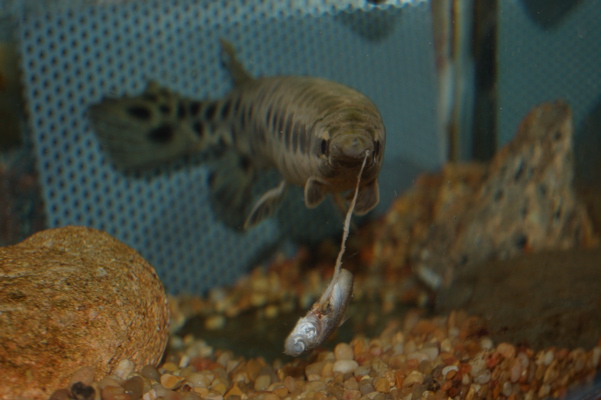April 24, 2007
A Simian Mug
Take a look at this fish. What would you say its face looks like?
The monkeyface-eel lives along the coasts in tidepools and eat mainly algae and crustaceans. A friend of mine has gone fishing for these, using a poke-pole, and says that they taste pretty good, though cleaning them can be problematic. Their skin is so slippery that it is hard to cut a fillet off of their body.
April 5, 2007
March 29, 2007
A tale of two fishes
What's the difference between the words "fish" and "fishes",? This was explained to me a few weeks ago in a lecture about fishes (and if you feel I've left anything out, please let me know):
Fish (I'm just dealing with the noun form, pertaining to language used by aquarists, keep in mind) can mean an individual or a group of the same species of fish.
Fishes, on the other hand, deals specifically with the plural of two or more species.
So does this mean that the sentence "I eat a lot of fish." is wrong if you enjoy eating salmon, tuna, yellowtail, barramundi, and other types of fishes? I don't think so, but I'll ask around.
Anyhow, on to the pictures. One fish pictured is a gar. The other fish is a goldfish. One of them ate the other one, and though the outcome was predictable, I was not expecting to see the following play out.
I don't know enough about gars to hazard a guess at which species this is, but I can tell you that it is the King (or Queen) of the tank.

Maneuvering by using mostly its muscular pectoral fins, the gar slowly positions itself for a meal.

The attack is lightning fast, and devastating to the goldfish. Pressure sensitive canals are lined up along its snout, and function much like a lateral line, letting the gar sense changes in water pressure. It attacks by lining its prey up right next to its mouth, and then snapping it up with its needle-like teeth while flexing its body to one side.

For some reason, the gar spat out its meal, and started to drag the disemboweled goldfish around. It reminded me of a master walking his dog.
After a few minutes, the intestines finally snapped, and the gar finished its grisly meal.
February 28, 2007
Mola mola mola mola mola
The Sunfish (aka Mola mola, Headfish, Mambou (Japanese), or as many children and adults call it, the Uglyfish) is one of the Aquarium's most popular attractions.
I would write a post dedicated to the Mola mola, but Fogonazos already has. Take a look here:
February 14, 2007
Tabehodai for white sharks
Like Calvin, I don't like to think of apex predators as scavengers. This is fascinating footage, but it is kind of disappointing to my childhood perceptions of white sharks, like the theories of the T. Rex being a scavenger made Calvin angry.
From a conservation standpoint, it is essential to dispel the myth of sharks as killing machines. The overwhelming majority of shark attacks on humans are accidental, and more people are killed by lightning each year than by sharks. Jaws is what we imagine a creature as awesome as the White Shark to be.
This isn't to say that shark myths shouldn't be preserved and enjoyed. Jaws was a good movie, and sharks make great antagonists in a story. These stories, however, shouldn't be used as justification for hunting sharks to the point where they are unable to sustain a healthy population.
Much in the same way that people should stop blaming violence on TV and in video games for the violence that occurs in the real world. When we're children, most of us can figure out the difference between the pretend world and reality. As long as some of us are unable to (which I am guessing is a very small minority), or, more commonly, are desperate for a scapegoat it will continue to be frustrating for those of us who have to watch these things unfold.
January 26, 2007
Frilled Shark Video
This eel-shaped shark was spotted a few days ago off the coast of Shizuoka prefecture. Prior to reading about the Frilled Shark (Chlamydoselachus anguineus) I had no idea that sharks other than the Six-gilled Shark had six gills.January 21, 2007
Of Boners and cataloguing fish
I have embarked upon a mission to catalog all of the fish on exhibit, including common names, scientific names, and Japanese names, along with interesting facts about these fish.
One thing I discovered while consulting "Probably More Than You Want To Know About The Fishes Of The Pacific Coast" by Milton Love (I highly recommend this book to anyone interested in the fish of the West coast of the U.S.) is that I have been mixing up the names of 2 similar, but different, fish.
Many people I have talked to have told me that "katsuo" is Japanese for "bonito", but this is wrong. The Pacific Bonito is "hagatsuo" in Japanese, while "katsuo" is actually a Skipjack Tuna, a species that only reaches about 40 inches in length.
Generally, Bonito, or "Boners" as some people like to call them, are not considered a delicious fish, but Love says that if you bleed them right away and keep them moist and cool they are good to eat.
Another interesting thing about Bonito, tuna, and other tuna-like fishes is that if you don't store them properly, they can develop scromboid poisoning which is caused by bacteria breaking down the flesh and creating histamines. The symptoms include "nausea, vomiting, and diarrhea..." (Love, p.315).
No treatment is listed, but I'm guessing that maybe you should treat this like food poisoning, maybe take an anti-histamine, and if things get bad enough, definitely seek professional help. Better yet, if the tuna smells funky, maybe you shouldn't eat it. If the can is bulging and releases a rancid gas when you pop the top, it's best to not eat that stuff. Scromboid, botulism, it doesn't matter- it's not worth risking your health!
This is a bit off of the topic, but my friend Matt asked if we have Albacore on exhibit. We do not, and it seems like they are not an easy fish to keep in captivity, so we probably won't be having any of those any time soon. Nor are there any Blue Sharks in the Outer Bay Exhibit.
Here's another weird tidbit. The Bluefins and Yellowfins are very, very hard to tell apart on exhibit. In Love's book, an easy way to tell these tuna apart is to look at the second dorsal fin. The Yellowfin's pectoral fin reaches the origin of the second dorsal fin, while the Bluefin's does not. Also, the Yellowfin's finlets are yellow, just as the name implies.
Yet, on exhibit, these two fish have morphed to such a degree that even the experts can't easily tell them apart. Whatever the case, the largest fish in this exhibit (estimated weight 600 lbs) are the Bluefin, which can get over 1000 lbs in the Pacific. Those fish are found closer to Japan, which is unfortunate for those of us in the States, and for the tuna. Irony is a b*tch sometimes...
January 17, 2007
White Shark Released
After 137 days with Monterey Bay Aquarium, the juvenile male white shark was released this morning. I feel lucky to have been able to see this one up close for the past month and to learn so much about it.
Here are some interesting bits of information:
The male shark was originally caught by MBA's white shark experts, by line and hook, just off of the coast of Malibu, California.
It's age is estimated at just over a year old.
This white shark was 5-feet, 8-inches, and weighed 104 pounds when he was first put on exhibit. Upon his release he had grown to 6-feet, 5-inches long and weighed 171 lbs.
This is the second white shark ever successfully kept on exhibit anywhere in the world. By "successful", I mean that the shark was able to safely navigate the exhibit he was placed in (the Outer Bay Exhibit) and took food. Monterey Bay Aquarium has been the only aquarium so far to do these things.
The female white shark was with the aquarium for 198 days and reached 6-foot, 4-inches with a weight of 162 pounds. During her time on exhibit, she grew 1 foot, 4 inches in length, and put on 100 pounds!
The male shark was released just off of Point Pinos, and was tagged with a 90 day PAT tag.
This shark never attacked any of his exhibit mates, instead feeding on plenty of wild-caught salmon steaks which were personally delivered to him on the end of a pole (the salmon was tied to the pole with an easily digestible cotton string, in order to prevent the voracious tunas from nabbing it).
During his stay, the white shark generally cruised towards the top of the exhibit with his dorsal fin occasionally breaking the surface of the water.
Flashes from people taking pictures seemed to cause the white shark to spend less time towards the front of the glass, and more time in the back of the exhibit where he was a little harder to spot.
It was amazing to see how many people's perceptions of sharks as malevolent, murderous monster were changed by simply watching him calmly cruising around the exhibit.
"Why isn't he attacking the other fish?" is a question often heard in the Outer Bay Exhibit. When people find out that these creatures don't kill everything in the oceans, and in fact help to keep the wildlife populations healthy, they want to learn more and generally start to develop an interest much different from the morbid, sensationalized portrayals that they are used to seeing on TV and in the movies.
A lot of people seem truly surprised to learn that most white shark attacks on humans are accidental. A human with four limbs sticking off of a surfboard looks like the silhouette of a sea lion or a seal from below. Upon tasting human, most white sharks don't seem to come back to for seconds. It's kind of like biting into what you think is a caramel flavored chocolate, and finding out that it is in fact the chocolate covered fruit and nut loaf.
Isn't it cool that the aquarium keeps its animals' welfare first and foremost in mind, when considering whether or not to keep them on exhibit or to release them. From what I've seen at aquariums around the world, this is not always the case.